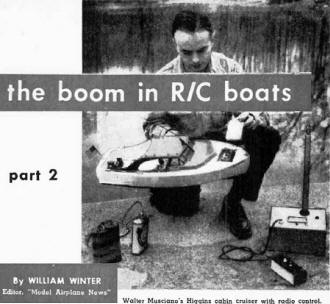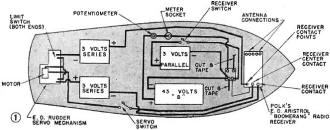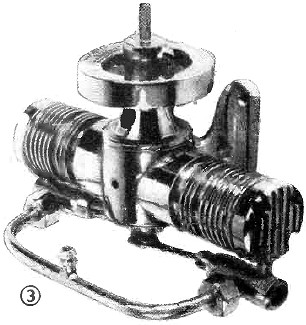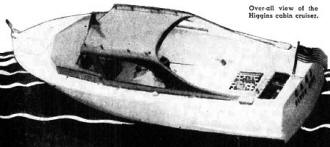|
May 1955 Popular Electronics
 Table
of Contents Table
of Contents
Wax nostalgic about and learn from the history of early electronics. See articles
from
Popular Electronics,
published October 1954 - April 1985. All copyrights are hereby acknowledged.
|
This
article entitled "The Boom in R/C Boats" appeared in the June 1955 edition of
Popular Electronics magazine which, during the early years
of its existence devoted quite a bit of print space to radio control airplanes,
boats and cars. As with all things electronics, a huge surge in consumer interest
was occurring with over-the-air communications.
Bill (William) Winter served as the editor of the Academy of Model
Aeronautics' (AMA's) American Modeler and American Aircraft Modeler
magazines from 1966 through 1974, but his efforts to promote all form of modeling
- airplanes, helicopters, cars, boats, trains, and rockets - covered many decades.
His first recorded article, "Building the Famous Udet Flamingo," (co-authored by
Walter McBride), was published in the March 1935 issue of Universal Model Airplane
News magazine. His 264th, "The Soft Touch," appeared in
Model Aviation (the
latest incarnation of the AMA's flagship magazine) in 1996.
See also "The
Boom in R/C Boats - Part 1," May 1955 Popular Electronics
The Boom in R/C Boats

Walter Musciano's Higgins cabin cruiser with radio control.
By William Winter
Editor, "Model Airplane News"
There was a time when the model boat hobbyist had to hack out his own propeller,
shafts, etc., but fortunately times have changed. The Dumas "Chris Craft Challenger,"
for example, has over 40 metal parts. O & R has a most complete hardware line.
For high speed operation they have cast bronze propellers, made by the dense lost
wax method, giving a closely moleculed prop for safe operation at speeds in excess
of 15,000 rpm, in sizes from 7/8 to 2 inches. O & R basic prop shaft sets exist
for every size of engine, from Half A up through the Dooling and McCoy racing .60's.
Shafts are in diameters of 1/8, 3/i6, and 5/32 inch.
A. J. Fisher, 1002 Etowah Avenue, Royal Oak, Mich., has deluxe unfinished cast
bronze propellers in sizes from to 4 inches, both two- and three-bladed. Fisher
rudder posts are milled to take soldered-on rudders; their stuffing boxes have packing
glands. They make air scoops, anchors, brass steering wheels, rear struts, etc.
Sterling has propeller drive sets for Half A, up to .29's and .35's, and for electric
drive. Berkeley has hardware for Class A and B engines, and for the little Half
A's.
Simple Receivers
The overwhelming majority of boats are equipped with a single channel receiver,
mounted on foam rubber to absorb engine vibration. Standard simple receivers now
on the market give a current change of as much as three mils, which is more than
adequate for good relay operation. Using these simple receivers, the average builder
goes in for control by rudder only, as does the plane builder. If he is smart, he'll
protect his equipment from water if there is a tendency to ship water while running.
The batteries can be coated with paraffin and the receivers tied up in
pliofilm
bags (used for storing food in refrigerators).

1) Block diagram of electric drive (E.D.) radio receiver and
rudder servo wiring for typical installation.

2) The Atwood .049 outboard motor has all the desirable features
of a big engine.

3) Two-cylinder inboard motor for larger models is built and
sold by the Allyson Co.

4) The Cameron .09 marine engine is water-cooled but is finned
for air cooling as well.
Balanced rudders are desirable. Rudders having the hinge line along their front
edge, or too close thereto, may be slow to respond and under severe conditions may
fail to turn the boat. Part of the area should be placed forward of the hinge line,
but not more than 25 per cent of the area.
Most of the airplane escapements often prove inadequate. Water loads on the rudder,
transferred through the linkage to the escapement (especially the compound variety),
result in sluggish rudder action. In some cases, the rudder may even be forced back
to neutral. Extra rubber and higher voltages are half way expedients that introduce
other problems, including that of critical spring tension. For best results, boats
require special escapements.
Escapement Mechanisms
One exceptional device is the E.D. clockwork escapement, manufactured in England,
and imported by Polks. Though big and rugged by plane standards, its positive action
and powerful clockwork spring make it a natural for boats. The enclosed spring will
give 200 movements, the last as powerful as the first. This gives 50 rudder positions
on a four-arm wheel, and 100 on a two-arm or self-neutralizing wheel. The unit comes
with both; they are readily interchangeable. The four-arm provides a rudder-hold
position that requires no current while holding; the two-arm does require current
while holding.
Cameron's motorboat escapement has a four-arm action. Its ability to take six,
or even more, strands of 1/8-inch rubber is extraordinary. Since the four-arm types
draw no current with rudder over, this escapement can be used with pen cell batteries,
despite the powerful rubber. The power behind this escapement means that even a
large boat can be maneuvered quickly. Some builders alter the well known Bonner
compound airplane escapement so that it closes contacts in its two positions, instead
of using it to move the rudder directly. These contacts can be used for a left-right
action of a motor driven servo, such as, again, Bonner (this servo is the same as
the elevator trim servo that comes with the Babcock three-channel radio). The third-control
contact could be for the engine or an ordinary self-neutralizing type can be reworked
to close contacts in two positions for use with a servo. Servos used in this way
give proportionate action but do not center automatically. The field is wide open
for home-built actuators; various stepping deals are most popular, although a complicated
multi-control system, using telephone dialing ground control, is not exactly quick
on the draw.
Servos
A number of servos exist, notably the Channel Master (Schmidt) and the DMECO's,
which come in four types. The DMECO's are designed to replace escapements and provide
the same "all or nothing" control movements, as opposed to the trim type of servo,
but have far more "muscle" than airplane escapements.
While one of the easiest ways to actuate a two-speed gas motor and shut-off is
by means of the electrical contacts of the Bonner compound, or of the DMECO multiservo,
ingenious builders have also adopted the E unit from toy trains. This is the gadget
that allows the train to stop, start, and reverse. Using this gadget with a compound
actuator permits some impressive maneuvering.
Over-All View of the Higgins Cabin Cruiser
The by now familiar pulse systems that have been evolved for airplanes are finding
increasing use on boats. In the simplest form, the pulse system uses a ground control
box (attached to the keying lead of the transmitter) which is small enough to hold
in the hand. Movements of the control stick in this box vary the pulse length from
no signal at one end to steady signal at the other. A magnetic type of actuator
slaves to the stick, and displaces the rudder one way or the other in proportion
to the movement of the stick. The actuator is connected to both sides of the relay
and, as the pulsing armature either slows down or speeds up, it tends to remain
for the greater time on either the dropped-out or pulled-in contact, as the case
may be. Similarly, the rudder, in following the actuator, governed by the relay,
remains for the greater time on one side or the other of the neutral position.
Proportional Control
In the boat field some wonderful proportionate actuators have been produced.
Two notable ones are the Steering Unit, Ripmax Marine Accessories, and the E.D.,
both English imported by Polks. They are similar so the description fits either.
A small 3-volt motor is connected by means of gearing or a belt to a threaded
screw about 4 inches long. Parallel to the screw is a slotted metal frame. Riding
on the threaded screw is a tapped block with a projecting drive pin that extends
through, and rides along the slot. To this pin is connected the rudder linkage.
The Steering Unit was designed for either multichannel or single channel use; for
single channel, a pulse system is needed.
For single channel use, a ground control box, or beep, or pulse box, is essential
to vary the pulse lengths. The Ripmax control box has two push buttons, a red one
(no signal) and a green one (steady signal). In neutral, the pulsing signal does
not cause the motor to turn, but with either steady or no signal, the motor turns
one way or the other (the polarity is reversed depending on the relay contact in
use). Pushing one button causes the boat to turn in one direction. Pushing the other
button returns the control to neutral or other desired position, or even to hard
over in the other direction. When neither button is depressed, the control will
remain at whatever position it was in. This type of steering does require some operational
skill in maneuvering the boat because it does not return automatically to neutral.
The pilot or captain, if you will, feeds in small heading corrections. Incidentally,
the maximum effective rudder movement is 22 1/2 degrees.
Still another pulse deal is the Fenners Pike, which was used to set an airplane
endurance record of approximately 90 minutes. In this compact and ingenious actuator
there is a small electric motor which slaves the rudder, without tendency to wiggle
as with most pulse systems, to the side-to-side movement of the ground unit control
stick. A button on the control box affects a change in pulse rate; the actuator
decodes the rate change to work a second control.
One of the cleverest proportionate actuators, the Flyball actuator, mounts on
a single-ply chassis, and consists of a Hi-Drive electric motor connected to a governor.
As the governor whirls, it expands radially, and therefore has linear contraction.
This movement pulls in a rod to move the control in proportion to the movement of
the governor. When the motor slows down, the governor reverses the action. A coil
spring or rubber band is attached to one side of the rudder, tending to hold it
hard over when the governor is relaxed, corresponding to the slow motor condition.
When the governor pulls in, it overcomes the pull of the spring to move the rudder
toward the opposite side. Here again the actual rudder position depends on the length
of the signals being sent, because the receiver's relay favors either a pulled-in
or dropped-out contact, as the case may be, with the actuator speed varying accordingly.
Multichannel Units

Overall view of the Higgins cabin cruiser.
For prices ranging from approximately $150 to $225, the well-heeled hobbyist
can purchase any one of the perhaps half dozen multichannel units now in widespread
use or, if he is experienced with electronics, he can dream up his own. But consider
that a five-channel receiver makes use of a reed bank; the five relays cost nearly
$40 by themselves. The three-channel receiver ordinarily would operate semi-proportionate
type servos for left and right, and some manner of engine control from the third
channel. Or, by properly combining a reworked escapement on one channel, that channel
can work a rudder servo, leaving two channels free for other uses. Inasmuch as compound
escapements or multiservos, or other actuators, can be used with each of the remaining
two channels, an almost infinite number of controls can be effected. The possibilities
of a five-channel set defy description: on-and-off running lights, raising flags,
even lowering a dingy, are a few examples. One chap has music coming out of his
river boat!
Kit manufacturers have some sensational ideas up their sleeves. This boat business
is much more than a passing fancy. Try it and see!
|